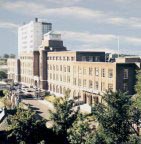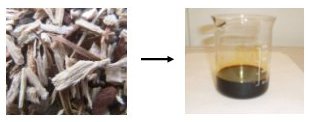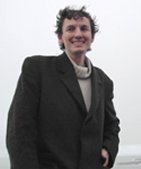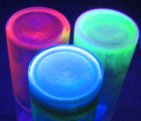Peace talks and an IRA ceasefire were only dreamed of the last time I visited the city of Belfast in Northern Ireland and the Queen’s University. Indeed, at the time there were still a few grey armoured vehicles on the streets and the city centre was still gated. There were British soldiers patrolling outlying villages and on the day I departed there was a major bomb scare at an unopened shopping centre, which meant a long-winded taxi diversion back to the airport. Times have changed.
The peace process has brought a new calm and a new exuberance to the city. On my second visit, the gates and the guards were gone and although the streets are eerily empty after ten on a mid-week evening and many shops remain boarded, there is a steadily growing enthusiasm that good times are just around the corner. Grey skies and rain of day one of my visit gave way to a much brighter outlook with a greener hue. The infectious enthusiasm of A.P. de Silva, a Professor of Chemistry at Queen’s, reflected that change with talk of cutting edge chemical research and development in his department.

A.P. de Silva and his team
Northern Ireland lost what chemical industry it had during the Troubles, de Silva told me, with perhaps two notable exceptions. Even now, he adds, the main players are home-grown. These are in the medical diagnostics and contract chemical synthesis areas. However, in recent years, a couple of big US companies in the electronics sector have come to Northern Ireland. They carry out a lot of electrochemistry and metal deposition work, de Silva says, and taken together have provided good job opportunities to the graduates that we produce. Queen’s used to lose a lot of potential students to Scottish universities, he says. But not now. With fees coming in, NI students tend to go to their local university. So our intake has been increasing nicely. With the new industrial opportunities and those in the South combined, de Silva is confident that there are now excellent job prospects for our graduates. This, he says, was demonstrated by The Guardian newspaper’s ranking QUB in the Top 3.

David Keir Building
Aside from individual researchers working within Chemistry and Chemical Engineering, the department plays host to several award-winning and high-profile centres, including QUESTOR (Queen’s University Environmental Science and Technology Research), QUILL (Queen’s University Ionic Liquids Laboratory), Synthetic and Bioorganic Chemistry (SYNBIOC), Innovative Molecular Materials (IMM) and CENTACAT (Centre for the Theory and Application of Catalysis). For such a small department – less than 40 faculty members compared with Oxford’s 75 in Chemistry alone – it is surprisingly well-equipped and its state-of the-art equipment is supported by powerful computational facilities.
Beyond the snazzy new university logos, truncated Qs, and mission statements lies a thriving department that has attracted to its membership several high-performing researchers from some prestigious international laboratories. Among them are such rising stars as Frederic Meunier who has worked with pioneering catalytic chemist Marc Ledoux at Strasbourg, Raman spectroscopist and Innovative Molecular Materials scientist Steven Bell, and Joe Vyle an alumnus of the laboratory of Marv Caruthers in Boulder, Colorado, who invented the chemistry used during the past 20 years for synthesising DNA on machines. And, of course, de Silva whose pioneering work in molecular logic has already led to multimillion dollar sensor technologies and is making inroads into the world of combinatorial chemistry through the development of molecular computational identification (MCID). MCID could ultimately provide unique tags for hundreds of thousands of nanoscopic or microscopic objects such as drug or catalytic molecules and the components of nanotechnology.

Frederic Meunier
The work of Queen’s rising stars, too, is just as revolutionary. Meunier, who works under the CENTACAT umbrella, for instance, is hoping to provide the currency of the hydrogen economy using some clever catalysis to transform biomass into a supply that can be used to produce hydrocarbons for industry and hydrogen itself for powering the fuel cells that lie at the heart of plans for sustainable power supply. To this end, he and his colleagues are currently testing catalysts such as platinum and rhodium lining the myriad pores within a material such as porous alumina or cerium zirconate.
Production of bio-oil from biomass involves using high temperatures for a very short period of time, explains Meunier, we are developing noble metal catalysts that allow us to convert this fast pyrolysis bio-oil to various hydrocarbon gases plus hydrogen by steam reforming. The primary interest in using bio-oil is one of volume and transport, Meunier told us, it is much easier to distribute and handle bio-oil than bulky biomass in its raw state.
Biomass can come in the form of agricultural waste (both crop and animal), by-products of the timber industry, food waste, and animal and human manures, among other materials. The conversion of biomass to bio-oil reduces the volume, increases the energy density of the material, and provides a renewable resource that can empower remote sites, particularly in the developing world.
In order to make their catalyst as efficient as possible for the production of bio-oil, Meunier and his colleagues are using a raft of analytical techniques to track the chemical reactions being accelerated by the noble metals within the porous solid. By combining results from infrared spectroscopy and mass spectrometry carried out as the reactions take place, the team has been able to show that chemicals present in the reaction mixture that were previously thought to be merely spectators, are in fact minor players on the reaction cast list.

Biomass to Bio-oil could power the hydrogen economy (Adapted from Meunier et al)
Meanwhile, researchers within QUILL continue to develop countless new ionic liquids and find novel applications. Co-director Martyn Earle told me that the centre is going from strength to strength with some eighteen or so industrial partners providing the impetus for much of the R&D. Ten years ago there were about 20 published papers per year discussing ionic liquids, five years ago there were well over 200 each year, but now there are annually six to seven thousand and the potential for that to reach ten thousand by the end of this year, Earle says.

Kenneth Seddon
The initial motivation for QUB chemist and QUILL Co-director Kenneth Seddon, who has pioneered much of the work on room temperature ionic liquids, and authored several of those early 20 papers, was to find a safer and more effective alternative to the volatile organic compounds (VOCs) used as industrial solvents. VOCs gained notoriety for their potential effects on health and the environment. It was their volatility and toxicity that made them most pernicious and chemists began hunting for alternative materials that could dissolve a wide range of materials without the associated problems. Room temperature ionic liquids seemed to be the answer
RTILs were originally discovered in 1905, the first example being ethylammonium nitrate, and are really nothing more than salts that happen to have a melting point close to room temperature and so are commonly liquid at every day temperatures. They now have some very diverse applications, Earle told me, Of course, they are used as solvents but also as high-performance lubricants because their charged particles stick to surfaces and reduce wear, they have been used as embalming fluids, paint additives that provide more uniform colour, and potentially as the propellant for ion drive spacecraft.
Earle revealed that there are millions of possible RTILs that QUILL scientists can make. They simply pick two suitable ions to make a test material, which can take minutes or just a few hours. The product is inherently an ionic material and if it is liquid at room temperature then by default it is an RTIL. One experimental group of RTILs being developed at QUILL is the generic magnesium-bromide class. The exact details of the ionic components of the Mg-Br ionic liquids remains a secret for the time being, but Earle showed me sample of which he is most proud. The material, simply a liquid in a flask, would be of no more interest than any other liquid found in a laboratory, except that this material glows with an intense green colour under ultraviolet illumination.
When the QUILL researchers tested this material they discovered that it also had some additional and equally intriguing physical properties, such as paramagnetism and liquid crystal behaviour. Earle pointed out that similar RTILs that glow blue and red, the other two primary colours, have also been prepared, and hinted that the applications of a fluorescent, set of paramagnetic, liquid crystalline materials should perhaps be obvious to anyone with even a passing interest in display technology.

Joe Vyle
There are many other fascinating research threads being woven in Belfast. Steven Bell is developing new materials that allow him to test illicit drugs more effectively using Raman spectroscopy for forensic science and as a spin off is soon to launch a material that emerged from this work that has superhydrophobicity.
Vyle and his colleagues are using the chemical wile to synthesise molecular switches based on a molecular donut consisting of between 6 and 8 glucose molecules through which is threaded a switch attached to RNA or DNA. This research might one day mesh with the molecular logic of de Silva and his team. RNA accumulation in specific neurones in the brain is inextricably linked to memory formation and Vyle revealed that, the real thrust of the research is to understand the role of RNA in the memory consolidation process.

Luminescent ionic liquids based on manganese (green), cerium (blue), and europium (red) (Photo: Copyright Martyn J. Earle)
Elsewhere at QUB, chemical engineer John Breen and his team are hoping to build a catalytic converter for diesel engines. Such work is closely linked to Meunier and his bio-oil, at least at the developmental level, but may provide the missing link in endowing the highly efficient diesel engine with the green exhaust credentials of the petrol engine. Green science is a pervasive theme on the Emerald Isle, with husband and wife team Andrew and Patricia Marr finding novel ways to produce highly heat insulating, yet transparent foam-like materials that might be used to coat window glass and cut energy bills. The surprising source material for one of these glassy substitutes known as an aerogel is organic kitchen waste, which closes an environmental loop in the domestic sphere quite neatly.

Emerald Isle
The range of research projects underway at QUB today is incredible, much of it with ambitious long-term goals, that could eventually provide solutions to many of humanity’s troubles. While the world outside may have spent many years under grey skies, that fabled green hue provides a lush backdrop for many of the emerging advances in chemical science taking place on the Emerald Isle.
Further reading
A.P. de Silva
http://www.ch.qub.ac.uk/staff/desilva/index.html
Queen’s University Ionic Liquid Laboratories
http://quill.qub.ac.uk/
QUESTOR Centre
http://questor.qub.ac.uk/newsite/index.htm
Centre for the Theory and Application of Catalysis (CenTACat)
http://www.ch.qub.ac.uk/centacat.html
Synthetic and Bioorganic Chemistry (SYNBIOC)
http://www.ch.qub.ac.uk/synbioc.html
Innovative Molecular Materials (IMM) Group
http://www.ch.qub.ac.uk/imm.html
Department profiling, get in touch via this website
https://www.sciencebase.com
Suggested searches
catalysis
fuel cells
biomass
Raman spectroscopy